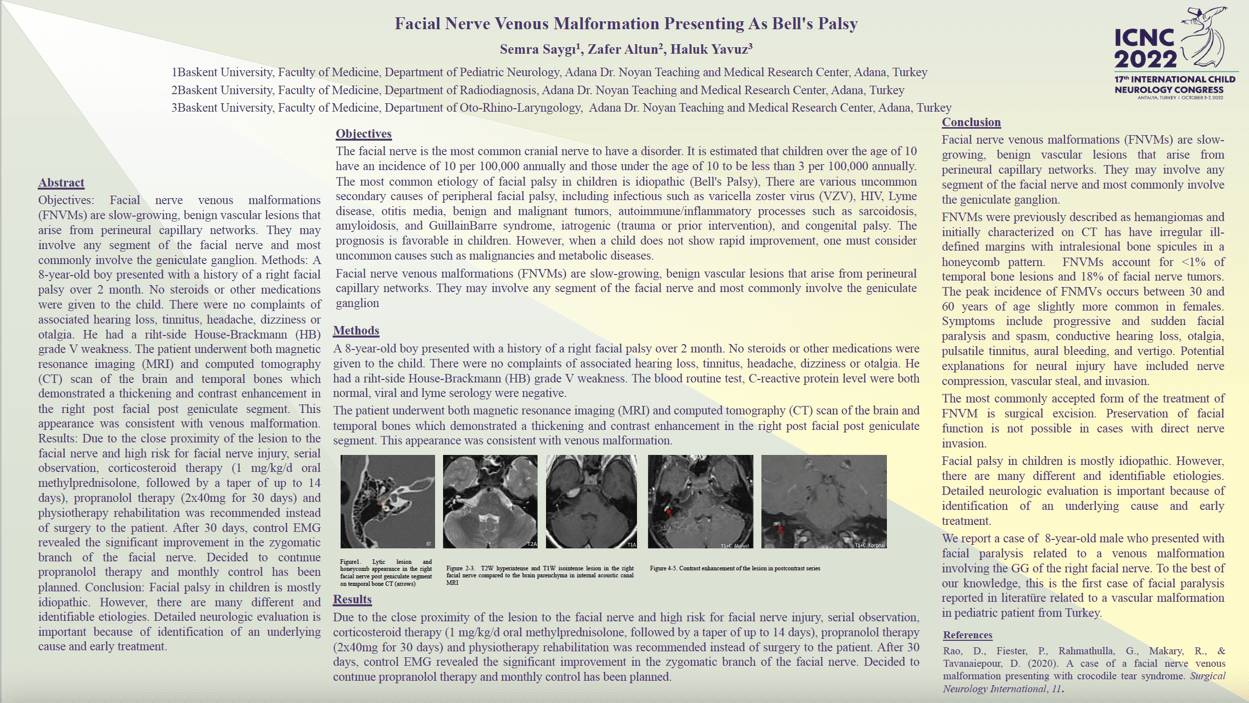Facial Nerve Venous Malformation Presenting As Bell's Palsy
SEMRA SAYGI, ZAFER ALTUN, HALUK YAVUZ
Objectives: Facial nerve venous malformations (FNVMs) are slow-growing, benign vascular lesions that arise from perineural capillary networks. They may involve any segment of the facial nerve and most commonly involve the geniculate ganglion. Methods: A 8-year-old boy presented with a history of a right facial palsy over 2 month. No steroids or other medications were given to the child. There were no complaints of associated hearing loss, tinnitus, headache, dizziness or otalgia. He had a riht-side House-Brackmann (HB) grade V weakness. The patient underwent both magnetic resonance imaging (MRI) and computed tomography (CT) scan of the brain and temporal bones which demonstrated a thickening and contrast enhancement in the right post facial post geniculate segment. This appearance was consistent with venous malformation. Results: Due to the close proximity of the lesion to the facial nerve and high risk for facial nerve injury, serial observation, corticosteroid therapy (1 mg/kg/d oral methylprednisolone, followed by a taper of up to 14 days), propranolol therapy (2x40mg for 30 days) and physiotherapy rehabilitation was recommended instead of surgery to the patient. After 30 days, control EMG revealed the significant improvement in the zygomatic branch of the facial nerve. Decided to contınue propranolol therapy and monthly control has been planned. Conclusion: Facial palsy in children is mostly idiopathic. However, there are many different and identifiable etiologies. Detailed neurologic evaluation is important because of identification of an underlying cause and early treatment.
Keywords: Facial Nerve Venous Malformation, Bell's Palsy, children
SEMRA SAYGI
Baskent University, Faculty of Medicine
Turkey
ZAFER ALTUN
Baskent University, Faculty of Medicine
Turkey
HALUK YAVUZ
Baskent University, Faculty of Medicine
Turkey
Objectives: Facial nerve venous malformations (FNVMs) are slow-growing, benign vascular lesions that arise from perineural capillary networks. They may involve any segment of the facial nerve and most commonly involve the geniculate ganglion. Methods: A 8-year-old boy presented with a history of a right facial palsy over 2 month. No steroids or other medications were given to the child. There were no complaints of associated hearing loss, tinnitus, headache, dizziness or otalgia. He had a riht-side House-Brackmann (HB) grade V weakness. The patient underwent both magnetic resonance imaging (MRI) and computed tomography (CT) scan of the brain and temporal bones which demonstrated a thickening and contrast enhancement in the right post facial post geniculate segment. This appearance was consistent with venous malformation. Results: Due to the close proximity of the lesion to the facial nerve and high risk for facial nerve injury, serial observation, corticosteroid therapy (1 mg/kg/d oral methylprednisolone, followed by a taper of up to 14 days), propranolol therapy (2x40mg for 30 days) and physiotherapy rehabilitation was recommended instead of surgery to the patient. After 30 days, control EMG revealed the significant improvement in the zygomatic branch of the facial nerve. Decided to contınue propranolol therapy and monthly control has been planned. Conclusion: Facial palsy in children is mostly idiopathic. However, there are many different and identifiable etiologies. Detailed neurologic evaluation is important because of identification of an underlying cause and early treatment.
Keywords: Facial Nerve Venous Malformation, Bell's Palsy, children
SEMRA SAYGI
Baskent University, Faculty of Medicine
Turkey
ZAFER ALTUN
Baskent University, Faculty of Medicine
Turkey
HALUK YAVUZ
Baskent University, Faculty of Medicine
Turkey

SEMRA SAYGI
Baskent University, Faculty of Medicine Turkey
Baskent University, Faculty of Medicine Turkey